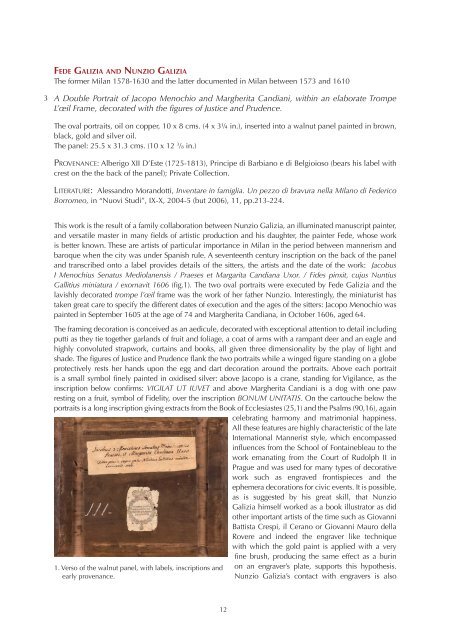Catalogue-2014-Jean-Luc-Baroni
- No tags were found...
You also want an ePaper? Increase the reach of your titles
YUMPU automatically turns print PDFs into web optimized ePapers that Google loves.
3<br />
Fede Galizia and Nunzio Galizia<br />
The former Milan 1578-1630 and the latter documented in Milan between 1573 and 1610<br />
A Double Portrait of Jacopo Menochio and Margherita Candiani, within an elaborate Trompe<br />
L’œil Frame, decorated with the figures of Justice and Prudence.<br />
The oval portraits, oil on copper, 10 x 8 cms. (4 x 3¼ in.), inserted into a walnut panel painted in brown,<br />
black, gold and silver oil.<br />
The panel: 25.5 x 31.3 cms. (10 x 12 3 /8 in.)<br />
Provenance: Alberigo XII D’Este (1725-1813), Principe di Barbiano e di Belgioioso (bears his label with<br />
crest on the the back of the panel); Private Collection.<br />
Literature: Alessandro Morandotti, Inventare in famiglia. Un pezzo di bravura nella Milano di Federico<br />
Borromeo, in “Nuovi Studi”, IX-X, 2004-5 (but 2006), 11, pp.213-224.<br />
This work is the result of a family collaboration between Nunzio Galizia, an illuminated manuscript painter,<br />
and versatile master in many fields of artistic production and his daughter, the painter Fede, whose work<br />
is better known. These are artists of particular importance in Milan in the period between mannerism and<br />
baroque when the city was under Spanish rule. A seventeenth century inscription on the back of the panel<br />
and transcribed onto a label provides details of the sitters, the artists and the date of the work: Jacobus<br />
I Menochius Senatus Mediolanensis / Praeses et Margarita Candiana Uxor. / Fides pinxit, cujus Nuntius<br />
Gallitius miniatura / exornavit 1606 (fig.1). The two oval portraits were executed by Fede Galizia and the<br />
lavishly decorated trompe l’œil frame was the work of her father Nunzio. Interestingly, the miniaturist has<br />
taken great care to specify the different dates of execution and the ages of the sitters: Jacopo Menochio was<br />
painted in September 1605 at the age of 74 and Margherita Candiana, in October 1606, aged 64.<br />
The framing decoration is conceived as an aedicule, decorated with exceptional attention to detail including<br />
putti as they tie together garlands of fruit and foliage, a coat of arms with a rampant deer and an eagle and<br />
highly convoluted strapwork, curtains and books, all given three dimensionality by the play of light and<br />
shade. The figures of Justice and Prudence flank the two portraits while a winged figure standing on a globe<br />
protectively rests her hands upon the egg and dart decoration around the portraits. Above each portrait<br />
is a small symbol finely painted in oxidised silver: above Jacopo is a crane, standing for Vigilance, as the<br />
inscription below confirms: VIGILAT UT IUVET and above Margherita Candiani is a dog with one paw<br />
resting on a fruit, symbol of Fidelity, over the inscription BONUM UNITATIS. On the cartouche below the<br />
portraits is a long inscription giving extracts from the Book of Ecclesiastes (25,1) and the Psalms (90,16), again<br />
celebrating harmony and matrimonial happiness.<br />
All these features are highly characteristic of the late<br />
International Mannerist style, which encompassed<br />
influences from the School of Fontainebleau to the<br />
work emanating from the Court of Rudolph II in<br />
Prague and was used for many types of decorative<br />
work such as engraved frontispieces and the<br />
ephemera decorations for civic events. It is possible,<br />
as is suggested by his great skill, that Nunzio<br />
Galizia himself worked as a book illustrator as did<br />
other important artists of the time such as Giovanni<br />
Battista Crespi, il Cerano or Giovanni Mauro della<br />
Rovere and indeed the engraver like technique<br />
with which the gold paint is applied with a very<br />
fine brush, producing the same effect as a burin<br />
1. Verso of the walnut panel, with labels, inscriptions and<br />
early provenance.<br />
on an engraver’s plate, supports this hypothesis.<br />
Nunzio Galizia’s contact with engravers is also<br />
12
















